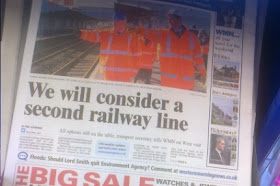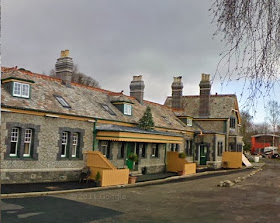Encouaging - or not. Words bandied about in addition to "consider" include "evaluate", "investigate" and "examine all options". It was Sir Humphrey Appleby of "Yes (Prime) Minister" who explained that the best way to prevent something ever happening was to commission a "full and frank" Government Enquiry. So don't hold your breath!
Most pundits, amateur and professional, would reject the Teign Valley route via Christow, shown here as part of the BBC local news graphic.
But what of the other line, shown above (incorrectly, as it happens) not quite joining back to the main line near Newton Abbot.
Dawlish By-Pass
The Great Western Railway started planning this brand new piece of railway in 1933. The initial plan was to leave the main line north of Dawlish Warren, call at a station to the north of Dawlish and rejoin the original line just east of Newton Abbot, near the no longer used Hackney canal channel.
The western junction would have been behind the trees (centre left) and just beyond the line of electricity pylons. The plan was later changed to leave the main line nearer Exeter at Exminster with a junction just south of the bridge over Milbury Lane.
Fast trains would have used the by-pass line, leaving (we assume?) local service to trundle round the coast. Such a line could be built today but it would involve several tunnels, specifically one under Haldon Hill. It would be expensive! But it would not impinge on the sensitive National Park. Detailed plans were made but the start of the work was interrupted by the outbreak of the Second World War and the scheme never saw the light of day post 1945.
fbb reckons that in more enjoyable economic times this would be a goer; but in our debt ridden economy it would not tick the financial cot-effectiveness criteria. HIGHLY UNLIKELY.
Southern Railway northern route
Southern Railway northern route
But there is already a line which once provided that alternative facility.
In the much vaunted days of private railway companies, ultimately days of wasteful and self-destructive competition, there were two main line rail routes from London to Plymouth. The Great Western (coastal) route remains; the alternative Southern Railway line ran inland via Okehampton having reached Exeter via Salisbury.
The GWR route reached Plymouth in 1848 and over 40 years later the Southern made it in 1890! As so often happens in railway history, it was "last in first out" with through trains over the moors ending in 1968. Passenger trains from Exeter to Okehampton lasted until 1972 but re-appeared in 1997 as a Sunday-only summer "tourist" service.
Freight used to run from Meldon Quarry west of Okehampton.
The quarry was considerably developed in 1897 to provide the majority of the track ballast requirements of the LSWR, which at the time amounted to about 100,000 tons per annum. The geology is such that the ballast is harder, and therefore more long-lasting, than stone available in the more easterly parts of the system. It was further extended in 1902, eventually reaching 200 acres. Further developed over the years, by 1953 it was producing 340,000 tons annually. An internal tramway of short and movable 2-feet gauge tramways was provided.
The quarry section is no longer in use but probably in working order.
The length of line between Plymouth and Bere Alston is still open for passengers as part of a service to Gunnislake.
So that leaves the bit in the middle, the dotted blue line on the map above. Most of the trackbed runs through open country ...
... and it would be a "simple" railway engineering job to reinstate the line. At Tavistock, the station is there and could be re-used, ...
... although currently it is privately owned and equipped as a series of holiday "cottages". It's on the market and you could buy it for £1,250,000!
The viaduct across part of the town is in good order ...
... and Quant Park is the name of the footpath and cutting south from the viaduct.
But, the current Devon County proposals for reopening from Bere Alston to Tavistock only envisage a single track line plus cycleway and a new station on the edge of town, leaving the infratructure as pictured above untouched.
As an aside, the last sentence (above) is unhelpful. One train a day is "regular"; and does it mean extra services at peak hours, and extra to what?
There will be objections to turning this paltry little extension into a main line. There will be protests from Tavistock residents who won't want trains past their back gardens, patios and conservatories and, most horrific of all, there will be mass demonstrations about intrusion into the National Park No doubt colonies of rare purple spotted glurks will be discovered nesting in a farm-access overbridge near Lydford.
Let's put it this way: IF the line were to be reconstructed it will create almost as big a furore as HS2. You have been warned!
fbb's guess is that, after the creation of a small moumtain of Men-from-the-Ministry bumf and lengthy consequent debate, it will be decided that on-going improvements for the exiting route will be the most cost-effective solution. Even if a diversion IS built, the existing line will need to be maintained as it is, de facto, the flood defence for the town of Dawlish!
And we wouldn't want to lose than magnificent view, would we?
And finally; a picture of the current rebuilding work in progress. For modern engineers, it's child's play!
... and it would be a "simple" railway engineering job to reinstate the line. At Tavistock, the station is there and could be re-used, ...
... although currently it is privately owned and equipped as a series of holiday "cottages". It's on the market and you could buy it for £1,250,000!
The viaduct across part of the town is in good order ...
... and Quant Park is the name of the footpath and cutting south from the viaduct.
But, the current Devon County proposals for reopening from Bere Alston to Tavistock only envisage a single track line plus cycleway and a new station on the edge of town, leaving the infratructure as pictured above untouched.
As an aside, the last sentence (above) is unhelpful. One train a day is "regular"; and does it mean extra services at peak hours, and extra to what?
There will be objections to turning this paltry little extension into a main line. There will be protests from Tavistock residents who won't want trains past their back gardens, patios and conservatories and, most horrific of all, there will be mass demonstrations about intrusion into the National Park No doubt colonies of rare purple spotted glurks will be discovered nesting in a farm-access overbridge near Lydford.
Let's put it this way: IF the line were to be reconstructed it will create almost as big a furore as HS2. You have been warned!
fbb's guess is that, after the creation of a small moumtain of Men-from-the-Ministry bumf and lengthy consequent debate, it will be decided that on-going improvements for the exiting route will be the most cost-effective solution. Even if a diversion IS built, the existing line will need to be maintained as it is, de facto, the flood defence for the town of Dawlish!
And we wouldn't want to lose than magnificent view, would we?
And finally; a picture of the current rebuilding work in progress. For modern engineers, it's child's play!
Next bus blog : Saturday 15th February















Glurks is good so keep your mitts off em
ReplyDeleteSince it appears the intention is less to replace and more to provide a diversion in the event of closure of the route past Dawlish, something that may become more common with the predicted increase in more extreme weather events. In this case the issue over big trains thundering past is lessened as an objection and sections of single-track is less of an issue as the intention is to try and maintain some semblance of a connections rather than be a major trunk routes at all times. If working to these parameters the route via Tavistock & Okehampton offers the best option (and appears favoured by Network Rail) as there are already moves to introduce a service from Tavistock to Plymouth and it is the route able to best support a local service along it (Exeter to Plymouth via Okehampton & Tavistock would appear to offer reasonable potential anyway) to help bear some of the cost of maintaining it.
ReplyDeleteAfter all that, do we believe that once the emergency has died down and the attention has moved on to something less interesting (like which politician says which stupid thing next) that this desire for a diversionary line will be maintained and the money will be stumped up to restore the line from Okehampton to Bere Alston? Of course not. Politicians have never found a promise they could make in a crisis that they couldn't forget about the moment the crisis was over.
After or before they have found someone lower down the political food chain that they can blame for it all and argue over which of them can then take the credit for identifying said individual/s.
ReplyDeleteThe remaining ones will still be expected to do even more with a lot less and still take the blame.
Perhaps its about time that someone suggested building some marina's, high end yacht clubs and associated country penthouses on the now flooded areas? After all with the bonuses that keep flowing out they must be running out of places to buy/put their gains. With the weather having cleared the locals out of the way and birdy thingys getting less priority (ahmmm you could even add in a wild fowl or whatever accidentally gets in the way of the barrells shootIIII)..........................
Cynic, cynic, cynic
The projected GWR avoiding line didn't go under Haldon Hill but took more of an easterly arc through the Earl of Devon's estate and the back of Dawlish. Parts were actually marked out in 1939. The biggest issue with this route now, ignored by the armchair 'experts',is the obstruction by extensive 60s/70s development in Teignmouth.The Dartmoor National Park Authority has actually welcomed the possible re-opening of the 'Southern' route - it will help green tourism. The NIMBYs, as you suspect, have started - the Daily Mail carried the story of the 'poor' owner trying to sell his restored station at Brentor. I agree with you that Dawlish will be repaired, the media circus will move on, and nothing else will happen!
ReplyDeleteThe LSWR route isn't what South Devon and Cornwall want or need though; we want more reliability and, if at all possible, a shorter/faster route to London. Runiing the long way round the moor and reversing at Exeter and Plymouth isn't ideal for that!
ReplyDeleteWhat Devon and Cornwall need and should be insisting on is mainline electrification. All else should be consistent with this.
ReplyDelete